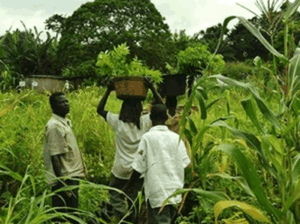Lack of farm labour affecting rural women farmers
 The lack of farm labour, both mechanised and manual, has been identified by rural women farmers as a major hindrance to their productivity.
The lack of farm labour, both mechanised and manual, has been identified by rural women farmers as a major hindrance to their productivity.
Women farmer groups in the Hohoe Municipality made this known, at ceremony held at Akpafu-Adorkor to recognize hard working farmers in the area.
They complained about the farm workload, which they said had risen sharply against available labour.
A member of Boeyawor, a farming group from Lolobi Ashambi said, “We cultivate a wide variety of crops and we need manual labour and farm machinery. We are suffering as women.”
Another group member said land tenure had also become expensive and affecting efforts at expanding farms.
The group also called on the assembly to help uproot trees and stumps that were making it difficult for the mechanisation of farms of members.
The members also spoke of the lack of standard pricing for farm produce and the bad state of the Eastern corridor highway.
Mr Teddy Ofori, the Municipal Chief Executive, said youth involvement in agriculture was vital to its growth.
He therefore appealed to the youth to take their place in the agricultural sector – make the most out of the opportunity offered by government’s Planting For Food and Jobs (PFJ) programme.
Mr Ofori said although over 6,000 farmers in the area registered under the PFJ, many failed to take advantage of subsidised inputs and other incentives.
The MCE announced that the Rearing For Food and Jobs programme was going to be rolled out in 2019, and asked the people to make good use of the opportunity to enhance their livelihoods.
Mr Abraham Asare, Project Officer of the Development Action Association, a Non-Governmental Organisation, facilitating the grouping of rural farmers, said it was extending its organisational and training programmes to benefit more communities.
Boeyawor Farmers Association was adjudged the best farmers group and received a tricycle, knapsack sprayers, wellington boots and other farm implements.
The group, made up of 30 farmers, currently has 47 acres of cash crops, in addition to 10 acres of palm, 15 acres of cocoa, livestock and honey bees.
Source: GNA
